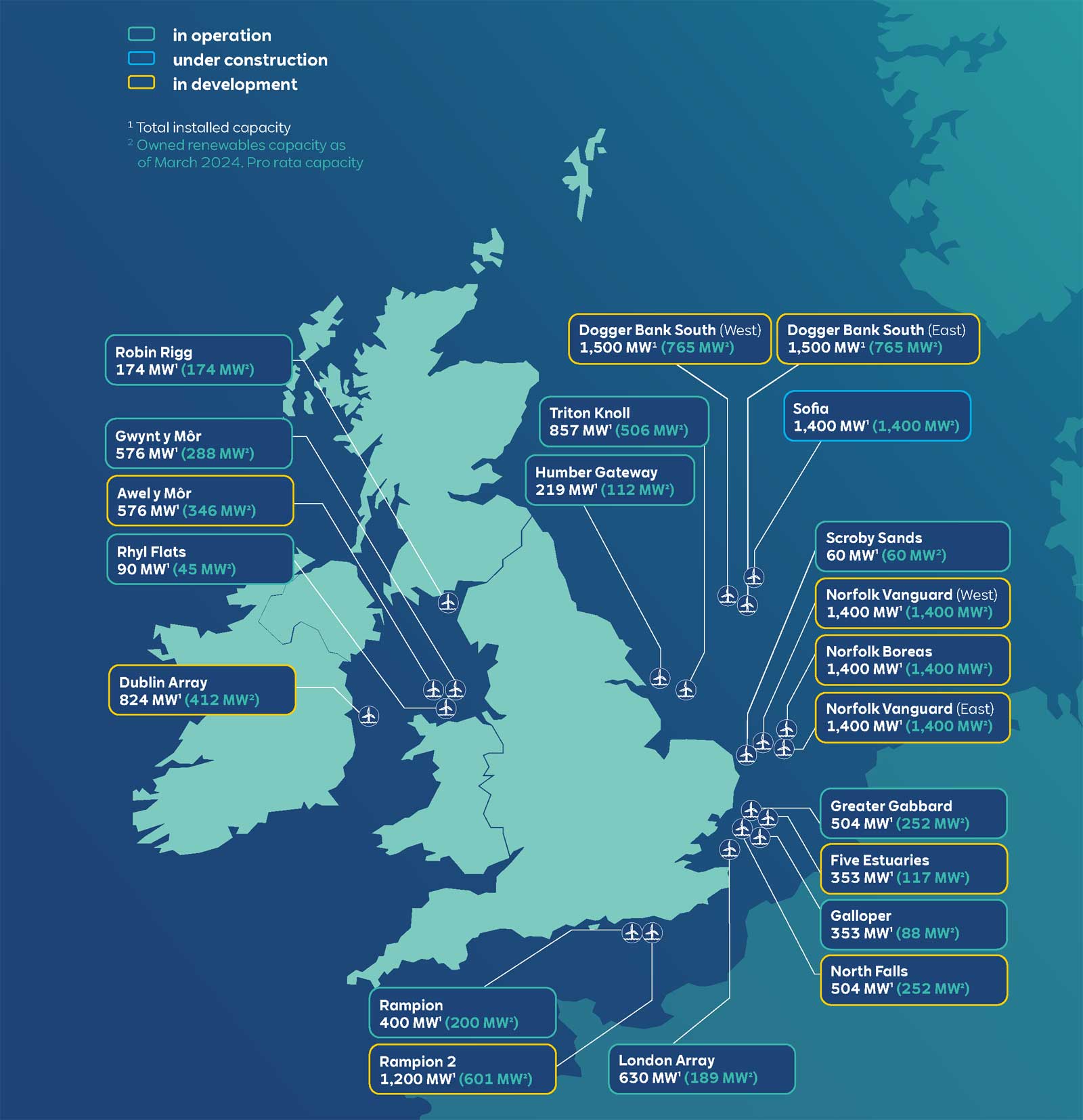Supply Chain Homepage
Offers central access to all important information, forms and contacts
RWE has pioneered UK offshore wind energy over two decades, having installed the first offshore turbines at Blyth in 2000, and commissioned the UK’s first commercial-scale offshore wind farm, North Hoyle, in 2004. RWE owns and/or operates 10 offshore wind farms in the UK - total installed capacity of 3.86GW (RWE pro rata share 1.9GW).
RWE has one of the largest offshore wind pipelines in the UK, and is a key partner in helping the Government achieve its target to increase its offshore wind capacity to 50GW by 2030.


offshore wind farms in operation
total installed capacity
projects in development
Following completion of the acquisition of the three Norfolk offshore wind projects, RWE is developing ten offshore wind projects in the UK & Ireland representing a combined potential installed capacity of over 10.5 GW, with RWE’s pro rata share amounting to around 7.5 GW.
RWE’s development pipeline includes four of the UK’s seven offshore wind extension projects which have received Agreements for Lease and, which once fully developed and constructed, will represent a potential total installed capacity of around 2.6 GW (RWE pro rata share 1.3 GW): Awel y Môr in North Wales, Rampion 2 off the Sussex Coast, Five Estuaries and North Falls off the coast of East Anglia.
With partner Masdar, RWE is also jointly developing the Dogger Bank South (DBS) Offshore Wind Farm projects in the North Sea, and is leading the project’s development, construction and operation on behalf of the partnership. The DBS projects comprise two separate sites, DBS East and DBS West, and have an estimated combined installed capacity of 3 GW.
RWE is also significantly well advanced with the construction of the 1.4 GW Sofia offshore wind project, located in the North Sea off the UK’s east coast.

Our offshore projects are constructed, operated and maintained via a range of ports and offices around the UK Coastline, including in the North East, Lincolnshire, East Anglia, Sussex, as well as Wales and the North West of England. Together both our Triton Knoll and Sofia projects represent a collective investment of £5 billion, and support a significant number of direct and indirect jobs in the Humber, North East and wider UK, throughout construction and longer-term operation.
RWE’s unparalleled track record of more than 20 years in offshore wind has resulted in 19 offshore wind farms in operation internationally, with a goal to triple its global offshore wind capacity from 3.3 GW today to 10 GW in 2030.
Offshore wind developments are proven, significant economic opportunities for the regions in which they operate, generating supply chain benefits, direct and indirect jobs and contracts. RWE has scale and experience and is in it for the long haul – we work with partners and suppliers to facilitate the kind of innovations, cost reductions and step changes that have made the UK a world leader in the sector.
Throughout the construction of our projects, we put our suppliers at the very heart, encouraging supply chain and economic growth, and establishing a lasting regional economic legacy in areas local to our sites. RWE projects use a dedicated Supplier Portal to help UK suppliers register for potential contracts. RWE’s Sofia Offshore Wind Farm provides a useful source of information for those looking to maximise opportunities in the sector.
RWE is aiming to become a market-leading floating wind player in strategic markets around the world. We welcome the UK Government’s target of delivering 5GW of Floating Wind capacity and are actively investigating a number of floating wind opportunities in the UK to support that – including in the Celtic Sea. Floating Wind presents an important economic opportunity for ports and industry, driving fresh investment, regional and national growth, and new, skilled jobs and careers for the future; RWE is committed to maximising these for UK and regional economies.
How does it work?
Floating wind uses the same turbines as conventional ‘seabed-fixed’ offshore wind but they are deployed on top of floating structures that are secured to the seabed with mooring lines and anchors. Electricity is transmitted to shore via subsea cables. As a less mature technology than seabed-fixed, floating wind is currently more expensive but costs are expected to fall rapidly so that it should be relatively cost competitive by 2030.
In 2021, Offshore wind farms operated by RWE contributed over £1.2 million to local community funds, including 139 different grants, and helped secure an additional £1.7million in matching funding. Our community funds are really flexible and designed to support what is most important to communities, with funding decisions made by panels of local people.
The wide and diverse range of projects funded through our wind farms make a real difference to communities, and include food kitchens for homeless people, conservation projects, forest schools, air source heat pumps and solar panels for community buildings, business start-up training for young people, and a neonatal nurse in a children's hospice care.
In 2021, RWE announced the development of the ‘Grimsby Hub’, a new state-of-the-art Operations and Maintenance Hub which will be home to RWE’s specialist team for major component exchanges and offshore repairs, with the creation of around 60 new jobs. The Grimsby Hub will enable the company to strengthen its relationship with the region’s businesses and local communities, by committing to a longer-term presence in the area.
The location of the Grimsby Hub was chosen because of its proximity to existing and future projects and its deep-water quayside, which is suited to the use of Service Operations Vessels (SOVs).
Through its offshore wind farms, the company has engaged with thousands of young people, encouraging STEM learning and raising awareness of the sector. In 2021, the Rampion Visitor Centre opened on the Brighton seafront as a place for young people to find out more about offshore wind and the myriad careers.
Since 2012, more than 40 offshore wind technicians have been trained, or are in training, through the RWE apprenticeship scheme. All our current and future offshore wind technicians will play a valuable role in this growing sector.



